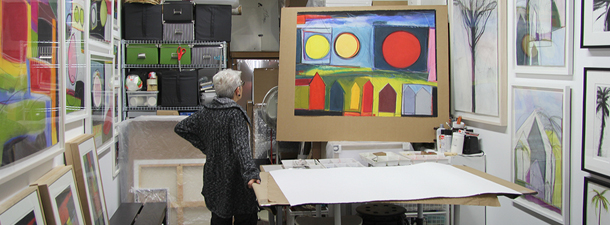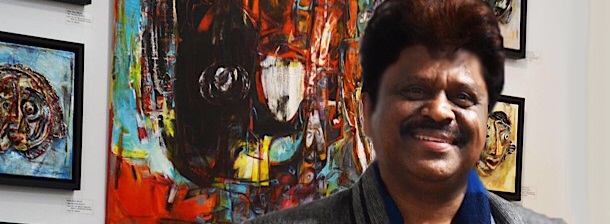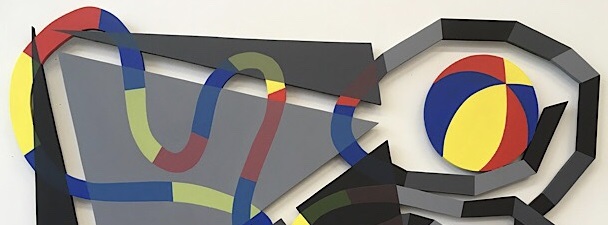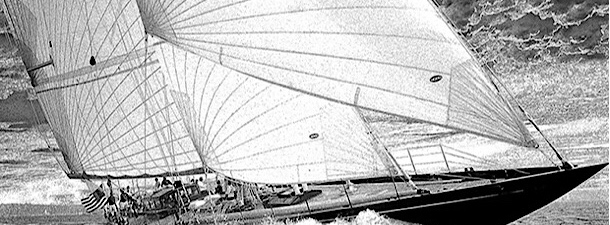Artist Louise van Vliet launches ‘CHOICE.EXPERT’ website

Louise van Vliet is an abstract artist who recently launched a website called ‘CHOICE.EXPERT’. The website enables subscribers to keep up with Louise’s projects and to play the EST – Emotional Spectrum Test game. This game gives players the chance to discover how they use their color choice to interpret their emotions via an interactive color spectrum. Moreover, the website includes three online courses, focusing on topics such as Self-Awareness and Emotional Intelligence, that aim to foster creativity and preserve memory. Louise recently discussed the website and her reasons for starting it:
Meagan Meehan (MM) of Entertainment Vine: What influenced you to become an artist and how did you get so interested in color?
 Louise van Vliet (LV): The first time I saw a horse, I must have been about 2 years old. It was a beach pony. My father was carrying me and I stretched out my arms to get closer to the animal which attracted me like an equine magnet. Later, before I could draw freehand, I would trace over pictures of horses, following the outline and watching as the curves transformed into a recognizable shape. I can’t remember a time when I wasn’t interested in shapes. Growing up on the West coast of Scotland I had lots of opportunities to observe color. My bedroom faced towards the sea and every night I would sneak out of bed and watch as the sun dipped behind the islands and the sky filled with color. No two sunsets were ever the same and in the course of 20 minutes I could watch what seemed like my own personal light show. With that sort of back-ground, it’s not difficult to become obsessed and impressed by color. The funny thing is, I never wanted to be a painter and instead became a sculptor, but that was years later, long after I had left Scotland and was living in the Netherlands. Perhaps the physical distance from the wild moors and hills woke up the images that were imprinted so clearly on my inner vision. I chose to work in wax and the first series of sculptures that I made were a collection of miniature islands which, when arranged randomly on a flat surface, gave the illusion of distance and the perspective of a bird of prey, looking down from a great height. I went on to create sculptures of falcons, dogs and horses, all of which suggested the idea of movement,even although they were solid objects. Having satisfied my feel for shape I turned to photography to provide a need for color. I spent 4 years making daily photographs of light filtered through colored bottles of oil and water. The results were fascinating. I started a blog and the reactions I received encouraged further investigation into how we see our world and how we can all find meaning in the apparently meaningless. This takes me right up to now and the creation of a further series of artworks, this time focusing on the topic of choice.
Louise van Vliet (LV): The first time I saw a horse, I must have been about 2 years old. It was a beach pony. My father was carrying me and I stretched out my arms to get closer to the animal which attracted me like an equine magnet. Later, before I could draw freehand, I would trace over pictures of horses, following the outline and watching as the curves transformed into a recognizable shape. I can’t remember a time when I wasn’t interested in shapes. Growing up on the West coast of Scotland I had lots of opportunities to observe color. My bedroom faced towards the sea and every night I would sneak out of bed and watch as the sun dipped behind the islands and the sky filled with color. No two sunsets were ever the same and in the course of 20 minutes I could watch what seemed like my own personal light show. With that sort of back-ground, it’s not difficult to become obsessed and impressed by color. The funny thing is, I never wanted to be a painter and instead became a sculptor, but that was years later, long after I had left Scotland and was living in the Netherlands. Perhaps the physical distance from the wild moors and hills woke up the images that were imprinted so clearly on my inner vision. I chose to work in wax and the first series of sculptures that I made were a collection of miniature islands which, when arranged randomly on a flat surface, gave the illusion of distance and the perspective of a bird of prey, looking down from a great height. I went on to create sculptures of falcons, dogs and horses, all of which suggested the idea of movement,even although they were solid objects. Having satisfied my feel for shape I turned to photography to provide a need for color. I spent 4 years making daily photographs of light filtered through colored bottles of oil and water. The results were fascinating. I started a blog and the reactions I received encouraged further investigation into how we see our world and how we can all find meaning in the apparently meaningless. This takes me right up to now and the creation of a further series of artworks, this time focusing on the topic of choice.
MM: What’s your favorite color?
LV: Now you’re asking! If I look at color from the CHOICE.EXPERT perspective then the colors I choose at any given time will vary according to how I feel about what I’m thinking about at that moment. The color choice would have nothing to do with liking or not liking but rather about which color or colors that attract my attention. If you are asking what colors do I like from an aesthetic point of view, I would choose burgundy and royal blue because these are colors that always make me look good and feel good.
MM: When and why did you decide to start ‘CHOICE.EXPERT’?
LV: I’ve always been good at decision making. And even better, at making choices that led to the results that I was looking for, even if some of those choices appeared at the time to be taking me in the opposite direction. By observing my feelings, I have an essential added input of trustable data that I can rely upon to help me make my choices. I wondered why it was that so many people said that they were bad at making choices. Faced with options, they often didn’t know what to choose for the best outcome. Because choosing is such a necessity in our daily lives, I decided to start an investigation into what it was that made choosing so difficult for so many. Of course, the first and most obvious reason is that we are scared that the wrong choice will have negative consequences, possibly long-term and so we hesitate, procrastinate and look around to see what others are choosing. We also like to be seen as winners, not losers, so even inconsequential choices can trigger hesitation and time-wasting avoidance as we try to decide not just what is the right thing to do but how our choice will be judged by others. Of all the factors that determine our success or failure, there is none greater than our ability to make choices that produce the results that we want. We may think that we want options and opportunities but given a series of options, the essential factor then, is knowing how and what to choose. And yet we are never taught how to make choices. We are raised to learn facts as if facts hold all the answers. Facts provide information but when facts are conflicting we still must choose which facts we are going to trust in order to make choices. Only by using our emotional input can we make choices. Facts are not enough. But unless we can become more aware of what our emotions are really telling us, then we will be lost in a sea of emotion. Working from the idea that color is the language of the emotions and shape is what connects everything to everything else, I brought these two factors together to create a system of personal exploration which acts like a simulator, a training ground, for making choices. ‘CHOICE.EXPERT’ evolved from an earlier project, a deck of 49 cards called Choice ~ a game without rules.
MM: Can you tell us a bit more about the color inspired Choice card game?
LV: One of the most appealing things about cards is the way they feel. Having a physical object to touch, move around and interact with gives the similar satisfaction that you get from handling a real book as opposed to a virtual book. I called the cards Choice ~ a game without rules and although there are no set rules, there are about 30 game suggestions for playing with the 49 cards, each of which features an original abstract colored artwork. I had a couple of hundred sets of cards made and these I distributed amongst friends and colleagues encompassing a wide area of expertise including shop-keepers, teachers, health professionals, artists, business people, parents, grandparents, students etc. They were given no instructions except to introduce the cards to as many people as possible and send me the feedback of their reactions. Calling Choice, a game without rules, was a deliberate attempt to challenge the potential players. I discovered very quickly that there are two distinct reactions to this challenge. The first reaction begins with a moment of confusion and irritation on hearing the name, “What do you mean a game without rules, surely that’s a contradiction?” And the second reaction came from those who said, “Fabulous, no restrictions. Let’s see what I can do with them!” Almost without exception, the first thing done after picking up the pack, is to sort the cards into two heaps, the like heap and the discarded heap. Having done that, the next step is to pick one card. This would normally be called the favorite card, except that what often happens is that a card is chosen and the chooser’s reaction is, “I don’t know why I chose that card, I don’t even like the colors”. That is what I would call a feeling choice. Chosen, not for a logical reason but simply because it felt like the card to choose at that moment. It is almost as if you are trying to tell yourself something. The explanation has nothing to do with magic but everything to do with our natural attraction to order and balance. Our bodies and our lives are in a constant state of flux. Movement is life, creativity and re-creativity, a constant. At the same time, we crave order and balance but from the point of view of a living being it is it essential that the balance is dynamic and not static. Working with individuals and groups using the Choice game, gave me the inspiration to create ‘CHOICE.EXPERT’. The Choice game still exists in card form, but in the past couple of years my vision has expanded beyond the need for “real” into virtual reality starting with computer access through ‘CHOICE.EXPERT’. A pack of cards is a convenient game to carry around but in the digital age of both reality and virtual reality, we are also able to carry cards and pictures with us wherever we go with our smartphones and laptops. Even art can be released from our walls and turned into virtual galleries.
MM: How can the game that became ‘CHOICE.EXPERT’ be played?
LV: ‘CHOICE.EXPERT’ can be used as a method to relax and refresh the mind, inspiring new thoughts and creativity, reviving memories, memory training and of real importance at this moment, releasing inhibitions to enhance communication both in family and in team-building situations. These apparently meaningless shapes seem to function like a language that speaks directly to that part of us that is more self-aware. The part that knows exactly what it likes, wants or needs. Remarks like “that reminds me of” and “I think it looks like – – – – what do you think?” and “when I look at this I feel calm, inspired, energetic, happy”, are all clear, spontaneous feeling statements awakened by looking at the abstract color pictures.
The second of the online courses being offered on ‘CHOICE.EXPERT’ is the three-part EPS – Emotional Placement System. which can be used both for memory training and as a personal GPS to help you as you take a journey into emotional self-awareness, helping you reach the destination you are aiming for every time you make choices.
The EPS includes an explanatory e-book, the 16-piecemovable grid (a beginner’s guide to self-awareness through color and shape) and the interactive image grid (that gives suggestions that can be used like sign posts tohelp you decide if you are travelling in the right direction).
MM: What are your goals for the website? Essentially, how do you envision it expanding?
LV: My main goal is to provide an inspiring online environment which can act as a platform for exploring and expanding self-awareness using color and shape, the building blocks of both our physical world and our emotional world. ‘CHOICE.EXPERT’ makes it easy to add to your self-awareness by offering the possibility to choose how you want to start. Whilst one person may focus on memory training, another will want to find a way to relax and reboot their brain whilst yet another is looking to improve a relationship or accelerate their career. The potential for expansion is enormous but the success of the expansion will come through my creative response to what those making use of ‘CHOICE.EXPERT’ want from the system. Every time someone benefits they become an enthusiastic promoter of this approach.
MM: Why do you think self-awareness is so important?
LV: Self-awareness gives you the opportunity to becomeaware of both your physical reaction to a situation and your emotional reaction. The feedback from your body is all important. Without self-awareness, what usually happens is, that feelings are suppressed and vital personal input is excluded from the decision-making process. Most of us can remember a moment when we chose for something that we felt was wrong for us but we ignored our feeling and went ahead. What did we feel at that moment? What warning did we ignore? It could have been a sinking feeling in the stomach or a shortening of breath but we felt it and suppressed it and later would say something like “I knew I shouldn’t have made that choice, I could feel it was the wrong thing to do”. Self-awareness is knowing that either you are or are not fully in agreement with the decision you are about to make and gives you the opportunity to take a step back and consider other options that feel better.
MM: What was the process of researching all the color meanings like?
LV: There has been a lot written about the meaning of colors and it Is not my intention to add another layer of learning. The words associated with the colors are not intended to be meanings but rather associations that you can agree with or disagree about. I am more interested in how you feel about a color than what I can tell you about what I feel.
MM: How have you seen colors impact people’s lives?
LV: A marketing friend asked me who my target group is and I found it impossible to say anything other than “people”. Young men and women around 30 who are facing major decisions about career and relationships; people in the 40’s with young families, work colleagues and staff to care for and to be responsible for as well as for their own health and well- being, balancing decision making alongside stress-management; people in their late 50’s, around whom all ages pivot, with grandchildren and aging parents; people reaching retirement and hoping to have the chance to explore some yet unfulfilled hopes and dreams; elderly people who haves stories to tell and need support to remember and share; people who find it difficult to know what they really want because the answer is inside themselves and not out there somewhere. Color is a language that breaks down barriers and opens communication with our self and with others. The testimonials I receive about ‘CHOICE.EXPERT ’are from people from all walks of life who have discovered their own way to increased self-awareness through color and shape, the building blocks of our world.
MM: To date, what has been the most rewarding part of being an artist and launching ‘CHOICE.EXPERT’?
LV: The most rewarding aspect of being an artist, is to see someone connecting with something that I created as if it was their own. When we really like someone or something it is because we see the best of our self in that person or object. The identification is in fact, recognition. ‘CHOICE.EXPERT’ takes this recognition to a level where it can be used as part of your own creative process. Not necessarily to create things but to create the life that you most want to live through the choices that you make with the help of increased self-awareness.
MM: Are you working on anything else right now?
LV: As it’s Springtime my thoughts are turning to my vegetable garden and the planting I’m going to be doing for the summer! I find outdoor practical work the perfect way to get inspiration for new projects. ‘CHOICE.EXPERT’is just beginning and in the coming months I will be expanding the range of online courses that are an effective stepwise approach to enhancing self-awareness, through sharpening observation skills, memory training and creative relaxation.
A few years ago, I led an event in Scotland, called the Art of Seeing and Being and I am planning a ‘CHOICE.EXPERT’ version of this positive experience for 2018. There are many excellent Scottish venues to choose from, which offer the opportunity to connect with all the senses. An artist should always be at least 10 years ahead of everyone else in their thinking, pushing the boundaries of what is possible. We have reached that point where the worlds of science, neuroscience, gaming and art can come together, making it possible for learning to be playful and where we all get to be explorers and pioneers. We can already use our own version of virtual reality, our imaginations, to expand consciousness and I am curious about the role that VR could play in enhancing the experience of my color rich abstract artwork.
* * * * *
To learn more about ‘CHOICE.EXPERT’, visit the official website.



